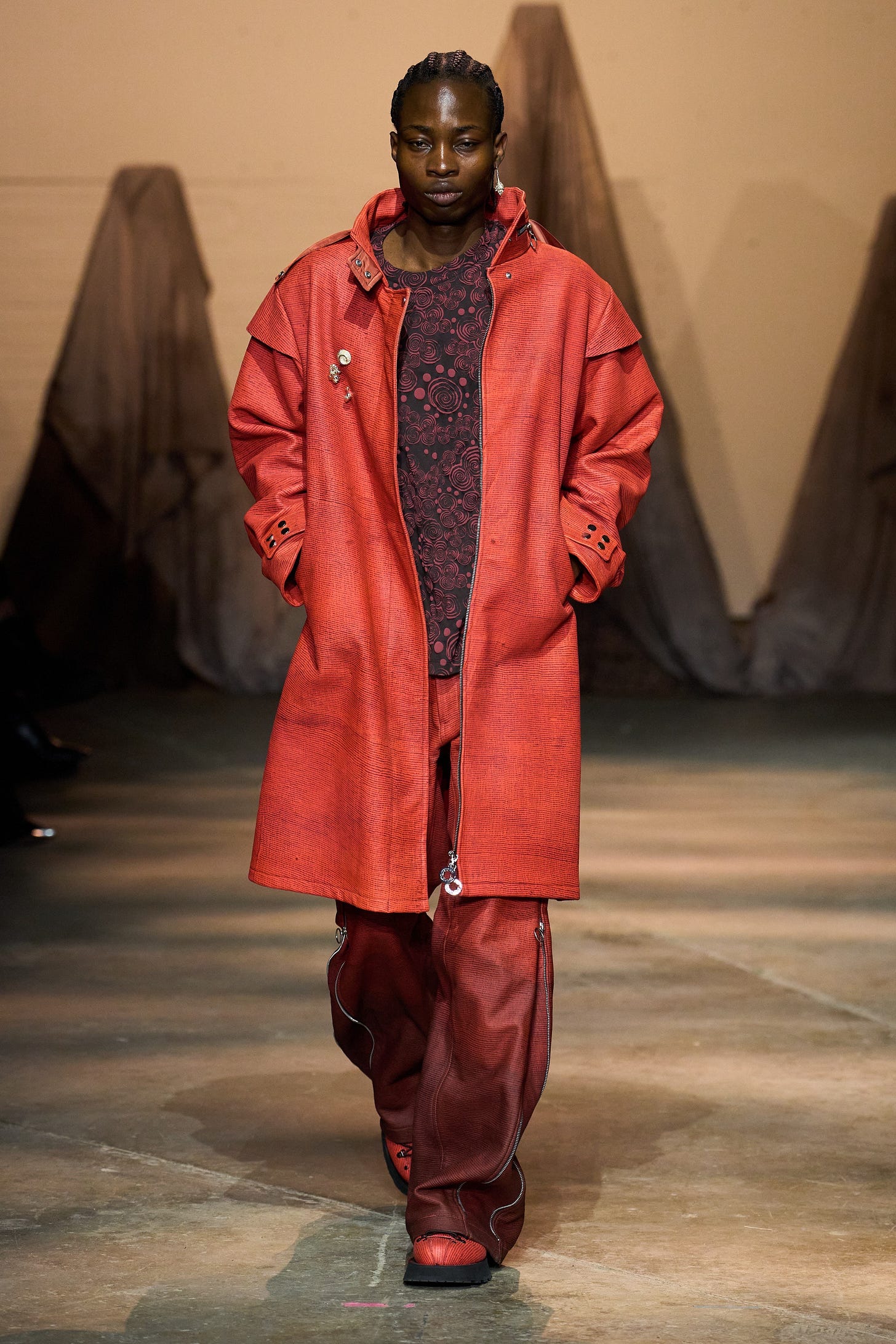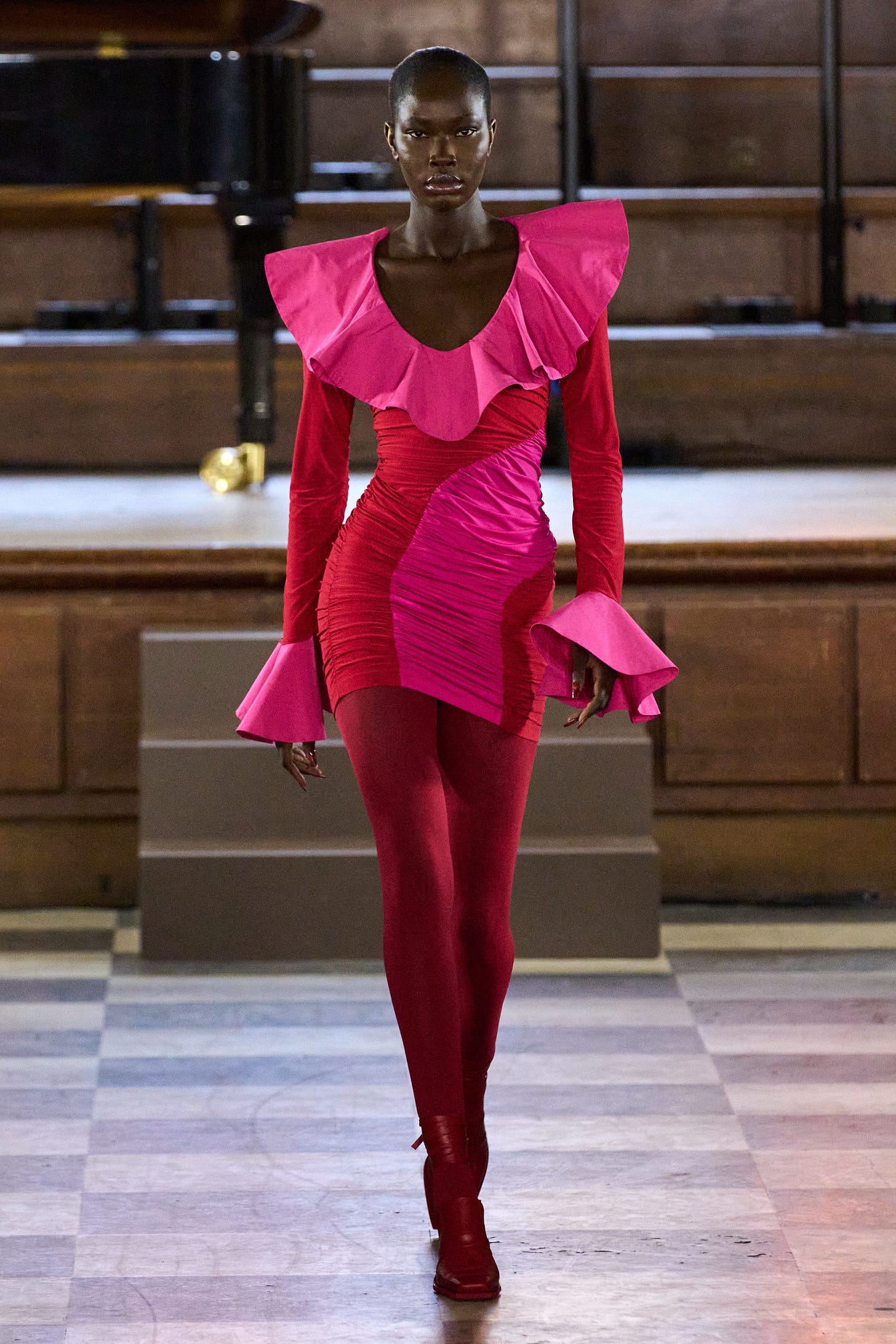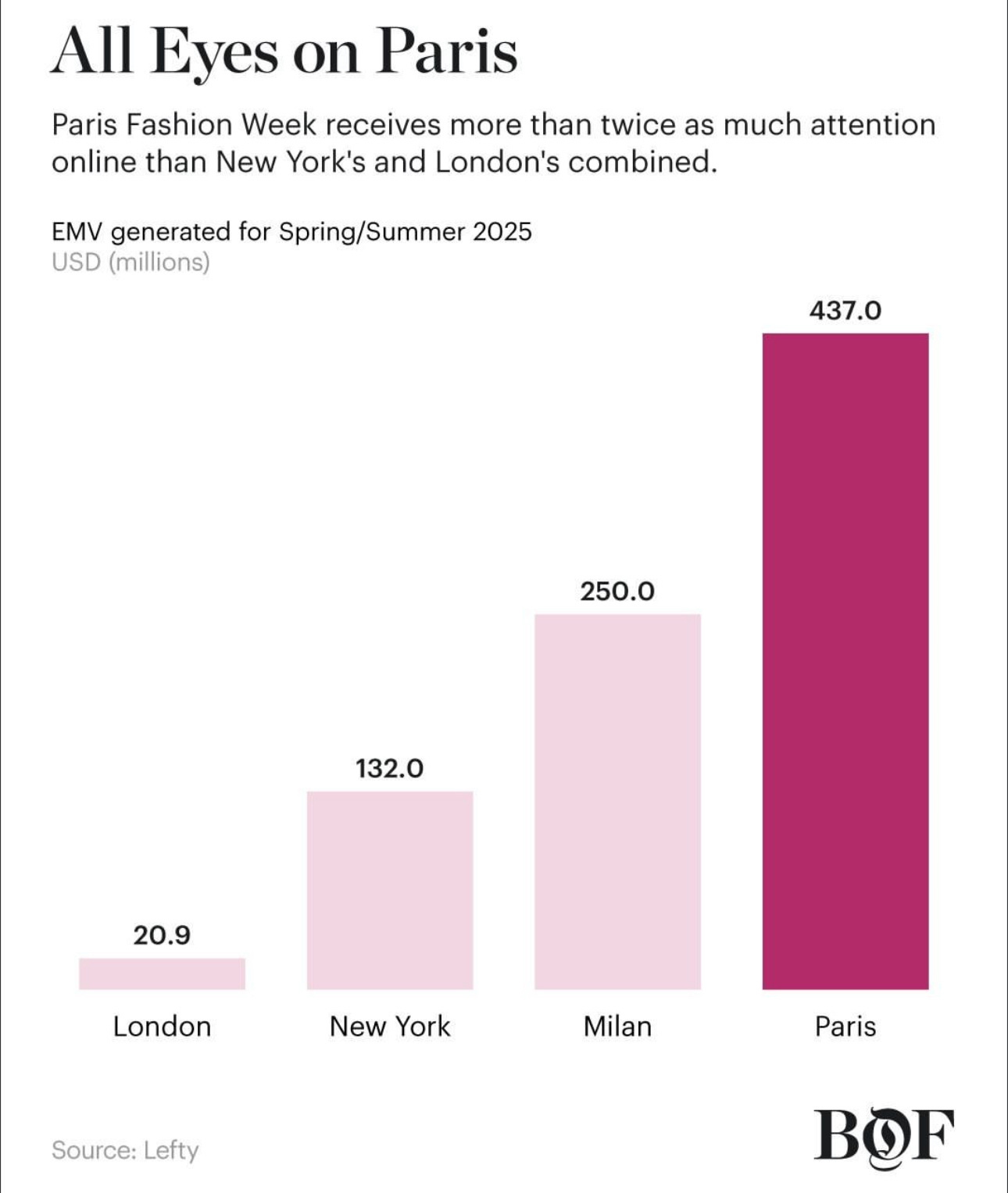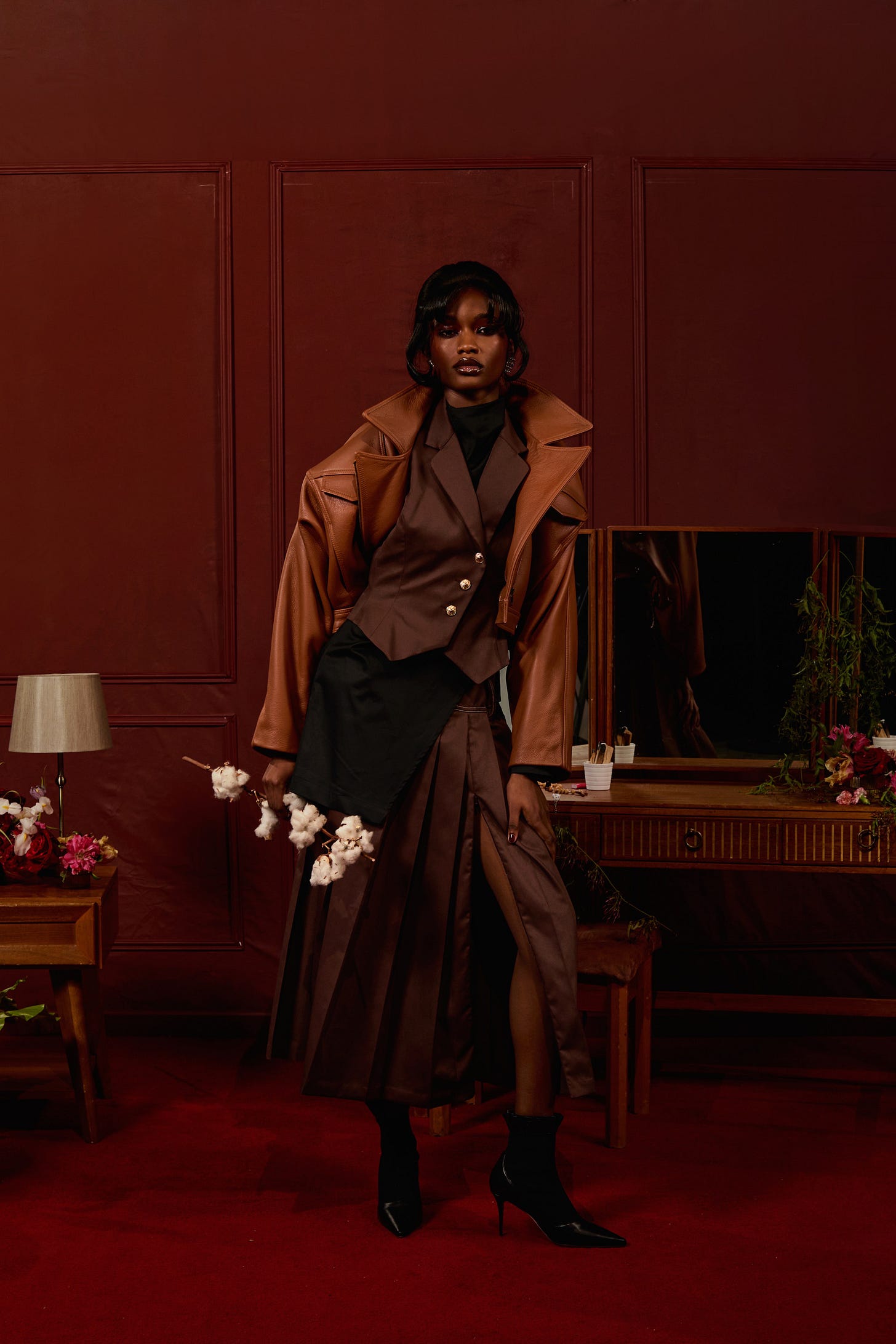THE PROBLEM WITH LONDON FASHION WEEK
London Fashion Week has been the weakest performer of the big 4 in recent years, its demise has been caused by a multiplicity of components.
London is the second most multicultural city on the planet. Its budding diversity is followed by a hotbed of talent across every sector of society, and fashion is no exception. Its multiculturalism has produced talent from all walks of life, such as Vivienne Westwood who largely pioneered the punk scene in the 80s, Ozwald Boateng who recontextualised the core tenets of sartorial British suits with his Ghanaian infusions, or Hussein Chalayan who was renowned for how he intertwined fashion, architecture, and science by emphasising technology’s influence within the discipline.
In recent times, London (and England as a whole) has produced a plethora of talent that stands out on the international stage, making significant contributions to the global fashion landscape. Designers such as Bianca Saunders, Martine Rose, Priya Ahluwalia, Nicholas Daley, Saul Nash, Daniel Lee, Stefan Cooke, Samuel Ross (formerly at A-Cold-Wall*), Maximilian Davis, Eastwood Danso, Mowalola Ogunlesi, and Dagye Adwoa, to name a few.
On top of homegrown talent, other designers migrate to London to attend Central Saint Martins, one of the most prestigious fashion schools in the world, headquartered in the city. Talents such as Traiceline Pratt, Dilara Findikoglu, Goom Heo, Nensi Dojaka and Kiko Kostadinov come from the Bahamas, Turkey, South Korea, Albania, and Bulgaria, respectively, to actualise their dreams of a successful fashion career. Both categories of designers contribute to a constant conveyor belt of talent for the British Fashion Council to nurture.
Now, how does a city that possesses one of the premier fashion education institutions, a top 4 destination on the fashion calendar, and a profusion of talent both locally and internationally, struggle to maintain its relevance in the contemporary fashion zeitgeist? Glad you asked. Walk with me.
In 2016, the UK government held a referendum on Brexit, which has had a profound influence on the country. With Britain's exit from the European Union and its removal from the common travel area, all the fashion press who would usually attend London Fashion Week now require a work visa to participate - a Tier 5 temporary work visa. The effect of this abrupt barrier to travelling for work was not limited only to foreign journalists, photographers, stockists, editors, public relations managers, social media managers, and event planners. It also extended to foreign stylists, set designers, hair and make-up artists, choreographers, and casting directors..
The fashion press generates hype around brands, which in turn leads to economic growth for participating brands. A major reason why Brexit has been and remains such a devastating blow to London Fashion Week is that it is primarily attended by young designers with fledgling labels. Attention from major fashion press publications such as Vogue, Harper’s Bazaar, Elle, and GQ Magazine is what platforms these brands to a global stage, the primary incentive for participating. Smaller publications such as Dazed, The Face, and i-D Magazine all have interactive audiences, but a significantly lesser reach in relation to popularity and influence.
In January 2021, Boris Johnson pledged £23 million in funding to the fishing industry in Britain to help compensate fishing businesses which had seen their exports to mainland Europe stifled by the introduction of post-Brexit checks. The fishing industry employs 24,000 workers in comparison to fashion’s 550,000 employees. Although there is a disparity in the number of employees in each sector, the British fashion industry was left to fend for itself, which led to mass layoffs. According to Retail Economics, British clothing exports fell by more than 60%, from £7.4 billion in 2019 to £2.7 billion in 2023.
This lack of funding caused British-based labels to opt out of showing their collections on native soil. Vivienne Westwood and Victoria Beckham have both shown multiple collections in Paris since 2021. Tomorrow Group, the conglomerate that owns A-Cold Wall*, Martine Rose, and Bianca Saunders, has its labels show their collections exclusively at Milan Fashion Week due to the monetary and publicity benefits (EMV) they stand to gain from doing so. This exodus has left the British Fashion Council scrambling to find replacements to fill the gaping holes in its local fashion calendar.
Tamara Cincik, CEO of Fashion Roundtable, a platform for dissecting all facets of fashion through research, groupthink, and discourse, stated that “for France, Brexit was a gift. We gifted our prominence in terms of talent and profile, while a business-savvy French government saw an opportunity, all while inducing customers to shop there for their high-end purchases.” via Politico.
French president Emmanuel Macron hosted a dinner at the Champs-Élysées, where he invited designers of famed French houses like Virgil Abloh, Jean-Paul Gaultier, and Christian Louboutin. Macron boldly proclaimed, “Choose France! My deepest wish is that creators will consider coming to our country, and that we get everything in order to make that work easy for them.”
Britain suffered a brain drain of talent as it saw, and is still seeing, many designers acquire lead design roles at foreign fashion houses. As of June 2025, its talents are spread out amongst various places such as Jonathan Anderson at Dior, Maximilian Davis at Ferragamo, Louise Trotter at Bottega Veneta, Sarah Burton at Givenchy, and Peter Copping at Lanvin. Britain is not short of talent, but Brexit has limited the opportunities available for the whole industry.
Brexit was a cantankerous decision that had a net negative impact on the British population; it spared no industry from the demise of an economic downturn, but showed little to no support to the fashion industry in a dire time of need. Boris Johnson and his cabinet showed no sign of empathy for one of its nation’s biggest industries by not allocating any funding to aid its transition into the new and less prosperous socioeconomic landscape. However, the fault does not solely fall on the government; the British Fashion Council (BFC) must shoulder a significant portion of the blame.
The British Fashion Council implemented one particular rule that has also had its negative effects on homegrown brands and London Fashion Week alike - a pay-to-play system. The majority of designers who graduate from Central Saint Martins are very well-versed in the cornerstones of design, not very much so in business. This means that they are already facing an uphill battle in trying to participate in a fashion week calendar that should be prioritised for them.
In 1993, the BFC launched the BFC NEWGEN initiative, which aimed to support the best emerging fashion design talent and build global, high-end brands of the future. Recipients were identified by their creativity, strong aesthetic and innovative approach to design. It then started to offer designers financial support, showcase opportunities, and mentorship to develop critical skills to future-proof their businesses. Some notable recipients for the 2025/26 iteration of the BFC NEWGEN grants are Tolu Coker, Charlie Constantinou, and Aaron Esh.

In 2019, the BFC launched a membership programme that required an annual subscription fee and established an international network for fledgling and prominent British designers. It aimed to assist designers at various stages in the fashion business, from emerging to notable brands. To create “access to an online portal featuring relevant industry news, government updates and insight reports, as well as opportunities to attend business development seminars, workshops and events from across the fashion industry,” via Fashion United.
As much as the membership and grant initiatives have their benefits, they are still very exclusionary in that they offer limited places to the large amount of design talent that London creates. Only a select few designers qualify for the BFC grant on an annual basis (19 for the 25/26 cycle), which leaves hundreds of other graduates without an avenue for financial support for their labels. When this is coupled with the aforementioned lack of fashion business acumen, it quickly becomes a breeding ground for early burnout.
The existence of an annual subscription membership programme means that younger brands have to pay to keep up with access to its perks. This is also an issue, as these brands are still expected to present shows, bankroll manufacturing, and fund marketing all by themselves. According to Politico, the average cost of showing a small collection with limited looks is around £7,000, an exorbitant amount that most young designers cannot afford. The language in the membership initiative alludes to access to mentorship rather than the provision of funds. Mentorship has its value, but in the battlefield of business, financial support is paramount.
With this growing number of young designers existing in the gap between university and an established business, companies have sprung up to assist newly graduated students with staging a graduate collection and more to attain stability. Fashion East is a non-profit talent incubator discovering, nurturing and showcasing emerging fashion designers. It was launched in 2000 by Lulu Kennedy, who set out to showcase the vast range of London’s brightest talents.
They usually provide support by staging the graduate collection, and three more after that to help smooth the transition from graduate to established label. Some of its most accomplished alumni include Kim Jones, Craig Green, Simone Rocha, and Wales Bonner. The organisation also launched the careers of aforementioned designers Maximilian Davis, Stefan Cooke, Martine Rose, Nensi Dojaka, and Mowalola Ogunlesi.
Other famous fashion councils operate similarly to the BFC but do not face similar issues due to circumstantial differences. The French fashion council, Fédération de la Haute Couture de la Mode (FHCM) and the Italian fashion council, Camera Nazionale della Moda Italiana (CNMI), both enforce pay-to-play systems for their fashion calendars. Both nations’ membership of the EU helps to maintain steadfast interest from all fashion press, where barriers faced by non-EU members, such as work visa requirements, are not a factor.
The FHCM do not have to worry about a talent exodus because Paris Fashion Week is the ne plus ultra of the fashion calendar. Designers congregate from all corners of the world to host showrooms in the city, where they garner publicity that they cannot attain from wherever they are based. The CNMI also see consistent success with Milan Fashion Week as it is the second most relevant event annually and has the Mittelmoda International Lab. This initiative is a grant to foreign designers, which covers travel and accommodation expenses for the qualifiers of said grant. This reflects a symbiotic relationship wherein it has financially elevated some labels and improved the profile of Milan Fashion Week.
Since Brexit will not be undone anytime soon, the BFC have to engineer more intensive measures to offset the emigration of their brightest talents. A temporary dissolution of the subscription to the membership programme to democratise the transition process for young designers could be a viable avenue. A diplomatic agreement could be struck between the BFC, the UK government and European counterparts to grant foreign fashion press easier access to London Fashion Week to boost earned media value in the hopes of ressurecting the public’s interest.
With the exit of the former BFC CEO of 16 years, Caroline Rush and the subsequent appointment of Laura Weir, the BFC may see a refresh. With interest and revenue generation at an all-time low, Weir can look to take some unorthodox swings to make up ground on the other big 3 in the annual fashion calendar. Copenhagen, Berlin, and Los Angeles are three cities with budding fashion weeks. London can feel the pressure. Progress will take time, but risks have to be taken because the only way to go for London Fashion Week is up.
London will never lack talent. It is too much of a metropolitan city with a rich melting pot of cultures and a globally-renowned tertiary fashion education institution to fail. It just needs restructuring and redirection, and a new regime under Laura Weir’s tutelage is in pole position to deliver exactly that.










JESAM NDINDI!